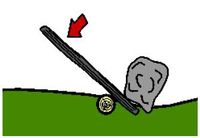Class 1 Lever: Difference between revisions
From DT Online
(Created Class 1 Lever) |
No edit summary |
||
| Line 3: | Line 3: | ||
This is the most common type of lever. With a '''Class 1 Lever''' the '''fulcrum''' is in the middle, like a see-saw. The '''effort''' is on one side and the '''load''' is on the other. | This is the most common type of lever. With a '''Class 1 Lever''' the '''fulcrum''' is in the middle, like a see-saw. The '''effort''' is on one side and the '''load''' is on the other. | ||
Common examples of Class 1 Levers include: a crowbar, scissors, pincers, | Common examples of Class 1 Levers include: a [https://en.wikipedia.org/wiki/Crowbar_%28tool%29 crowbar], [[scissors]], [https://en.wikipedia.org/wiki/Pincers_%28tool%29 pincers], [[tinsnips]], many [https://en.wikipedia.org/wiki/Bicycle_brake push-bike brake levers and calipers] and [https://en.wikipedia.org/wiki/Weighing_scale#Balance balance type weighing scales]. | ||
[[Category:Levers]] | [[Category:Levers]] | ||
[[Category:Primary]] | [[Category:Primary]] | ||
Revision as of 15:23, 7 February 2015
This is the most common type of lever. With a Class 1 Lever the fulcrum is in the middle, like a see-saw. The effort is on one side and the load is on the other.
Common examples of Class 1 Levers include: a crowbar, scissors, pincers, tinsnips, many push-bike brake levers and calipers and balance type weighing scales.
